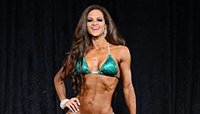Learning and practicing the poses required for a fitness or figure contest is one of the most important aspects of competition preparation.
In any NPC contest, fitness and figure athletes are required to learn the mandatory poses, of which there are four, also known as quarter turns. Athletes also need to have an individual presentation prepared for their individual introduction. Unless you've competed in a number of shows already, it's impossible to know and to properly display what the organization's judges are looking for.
As a regional-level NPC fitness and figure competitor, I've competed in over six shows in the past two years. Through these experiences and through judges' feedback, I've tweaked my posing per the NPC's standards, and I'm ready to share that information with you.
NPC Guidelines
Bodybuilding.com has the rules for judging a fitness/figure physique in the NPC. Read NPC Fitness Rules And Moves! .
Only through watching and competing in NPC events can a competitor really see how the poses are to be performed. Every few years the poses are altered, usually as a result of the IFBB altering the professional posing rules. This makes it important to stay informed of any new updates the organization may have, to ensure you are following the proper guidelines.
There is a video available through Repetrope Videos (www.repetrope.com) entitled "What are the Judges Looking for in Fitness and Figure." I've purchased and watched this video many times, and recommend it to any competitor, whether new or experienced.
NPC and IFBB judge Sandy Ranalli leads a seminar with several top NPC and IFBB competitors to clear up any confusion you may have on all matters pertaining to fitness and figure competition in the NPC.
What Are Quarter Turns?
These poses display the physique from each side - front, left, rear, and right, in that order. This gives the judges the opportunity to assess your physique and to compare it, part for part, with the other girls on stage from every possible angle.
While you might have an awesome physique with great symmetry and conditioning, perfect posing, or lack thereof, plays a major role in how well a competitor will fare at a contest. It can make or break close placements, especially in higher levels of competition.
After months of training and dieting, why would any competitor want to risk a placement by not taking the time to master her quarter turns? You're right, she wouldn't! So read on to learn how you can be one step ahead of the competition by mastering the NPC mandatory poses and developing a creative individual presentation for fitness and figure.
The poses are supposed to be "relaxed," but in reality they are anything but that! Your entire body must remain flexed at all times, yet appear to be totally relaxed and completely effortless. Gracefulness and flowing transitions complete the presentation package.
Quarter Turn 1 Facing Front
This will be the first pose the judges call after all the girls are lined up on stage. It will be the judges' first impression of your physique, so be sure to make it a good one!
In addition to remaining flexed, keep these pointers in mind during the front pose:
- Keep feet and legs together.
- If you have a smaller quad sweep, turning the toes out slightly will enhance the leg flare. If you have a big sweep, keep your toes pointing forward.
- Bend the knees slightly, only so they are not locked out.
- Turn the knees out to enhance the quad sweep.
- Squeeze your quads as hard as you can!
- Keep hips slightly bent, only so they are not locked out.
- Keep abs tight and torso fully extended.
- Keep chest up and out.
- Flare your lats to maximize upper body and minimize size of hips.
- Keep shoulders flexed and extended to the sides (the flaring of the lats will naturally push the shoulders outward). Do NOT hunch the shoulders!
- Keep upper arms tight, but relax arms from the elbows down, including hands.
- Keep elbows only slightly bent, neither too straight nor too bent.
- Make sure your arms don't flare out too far on your sides. Keep them in so that your hands are no more than about 6" from your hips.
- Keep your chin and head up and smile!
Quarter Turn 2 Facing Stage Right
This will be your second pose, and the first time the judges see your physique from the side (it will be your left side facing them). There is more room for variation in this pose, so it's important to display your strengths while hiding your weaknesses.
A slight twist of the torso is allowed, but too much of one will result in the head judge calling you out to face the side and to not twist.
Keep these things in mind during your side pose:
- Keep either the front facing leg or the rear facing leg slightly ahead of the other and the. This breaks up the line of the leg and makes your legs look fuller and curvier. Keep the knee of one leg bent slightly more than the other for the same reason.
- You may opt to pop the heel of your front facing leg (if that is the leg that you choose to bend at the knee). This puts more emphasis on the calves and better helps flex the hamstring.
- Extend the spine and bend at the hips to smooth the glutes and make the backside appear curvier.
- Keep abs in VERY tight. The ratio of your shoulders to waist is very visible in this pose.
- You arm placement may vary. You may opt to place your arms completely at your sides, or to slightly place the front arm to the rear and the back arm to the front of the body, creating a slight twist in the torso.
- The rear placement of the front arm brings out more definition and vascularity in your shoulder and bicep.
- Keep arms relaxed from the elbow down and including the hands.
- Keep your head and chin up, facing the side of the stage, and smile.
Quarter Turn 3 Facing Backstage
This pose is a very difficult one to master, and is one of the most important of all the quarter turns. It displays your back development and symmetry very well, and shows if you are lean enough in the lower body. The last thing you want is a jiggling set of glutes!
While this has a lot to do with conditioning and controlling water, it has a good deal to do with posing as well. It is very similar to the front facing quarter turn, but has its differences as well.
- Keep your feet and legs together.
- Balance most of your bodyweight on your toes to enhance your calves.
- Keep your hamstrings and glutes extremely tight, but don't squeeze your cheeks together. This destroys the natural female shape to the glutes and often brings out more wrinkles and any cellulite you may have.
- Stick your butt out and upward by bending over slightly at the hips and flexing your lower back very hard. This smoothes out the glutes to create a curvy, smooth line.
- Keep your entire back flexed very hard and flare your lats as far out as possible, then squeeze your back together slightly to bring out development in your middle back as well.
- Keep shoulders flexed and extended to the sides (the flaring of the lats will naturally push the shoulders outward). Do NOT hunch the shoulders!
- Keep upper arms tight, but relax arms from the elbows down, including hands.
- Keep elbows only slightly bent, neither too straight nor too bent.
- Make sure your arms don't flare out too far on your sides. Keep them in so that your hands are no more than about 6" from your hips.
- Be sure to sweep your hair to the side as you turn if it is long and worn down.
Quarter Turn 4 Facing Stage Left
This pose will be exactly the same as Quarter Turn #2 - Facing Stage Right.
Transitions
Just as important as hitting the poses themselves are how you look between poses. This is known as a transition. You should remain flexed, but still be relaxed enough to present a graceful and flowing movement as you ease into the next pose. Try not to look like a robot or a soldier when performing your turns.
The best way to transition is to step and turn your right foot, then follow with the left foot, and immediately hit your next pose. Move your arms by slightly following them behind your torso and into the next pose. Remember to keep smiling!
Practice walking in your heels around the house to get comfortable with wearing them. Make sure to walk on a hardwood floor to emulate the stage floor. Try out your transitions in front of a mirror until you find one that's right for you. By practicing over and over, and by watching videos of competitions, you will learn what looks good and what doesn't.
Individual Presentation
In almost all NPC shows, you will be introduced individually and have the opportunity to walk out on stage and perform your own individual posing presentation. The judges give you the freedom to choose which poses you do and how you do them. This is your chance to be creative and to show your best assets so that you really make an impression on the judges.
Choose Three Poses - a forward facing, rear facing, and side facing pose - and perform them in one of the following orders:
Choose either the front or side pose first, and always face the judges for your first and final poses. It doesn't look good to walk off stage after performing your rear facing quarter turn! Make these poses individual by adding bends, dips, bows and waves to your presentation. Hold each pose for 3-5 seconds.
I always hear judges say that competitors rush on and off stage too quickly for them to see their physiques. Be sure to exude confidence and gracefulness from the moment you step on stage. Walk out with your head up and facing the audience or judges, smiling, and waving to the audience.
It's nice to end the presentation with a slight bow and/or wave before walking off stage, all the while looking at the audience and SMILING!
Casual Pose
There will be times when you are on stage for a very long time, or when the judges tell you to "relax." Well, you know you can't just let it all hang out and shake out your legs on stage! So, what should you do? This is the time to hit your casual pose.
Your casual pose is a slightly forward, slightly sideways pose that allows you to rest a bit from the mandatories, while still remaining poised and presentable.
This pose is also very individual, but keep the following items in mind when choosing your casual pose:
- You should always face forward.
- Your number should always be visible.
- Keep a slight twist in the waist - don't face completely to the side or completely to the front.
- Bend one leg so you can shift your weight when one foot/leg gets tired.
- You can rest one arm or the other by placing it on your hip.
Remember to keep smiling, remain tight, and face forward even when in your casual pose. You are being watched the entire time you're on stage, so make sure you exude grace and professionalism at all times. And don't forget, you never know when someone is going to snap a picture of you, so make sure you're always ready!
Posing Follies
I've seen and heard of many competitors doing things on stage that just shouldn't be done. They look unprofessional and just plain ruin your presentation.
Here is a list of just a few of these things:
- Pick Your Suit: Please don't do this! I saw a picture of a girl doing this and it did NOT look good. Make sure you are glued in with Bikini Bite so you don't have to worry about your suit riding up.
- Lick Your Teeth: I've done this and have seen pics of me doing this, and let me tell you, it looks bad! Make sure to put Vaseline on your teeth so you don't have to lick them on stage.
- Relax Your Muscles: I've seen girls with jiggling glutes, bellies hanging out, and sagging shoulders. This also looks really bad.
- Cup Your Hands: I really think this looks bad during posing, especially if the thumb is sticking out while all other fingers are locked tightly together. Keep all fingers slightly separated and pointed downward, yet still bent and soft. It looks too fake and rigid any other way.
Practicing The Poses
All poses should be practiced while wearing your actual competition heels. Your physique will look and move differently depending on the shoes you are wearing. You should try to practice the poses and transitions on a hardwood floor so you get the feel of the flooring that you will be turning on the day of the show.
If you've never competed, you should start practicing the poses immediately, once or twice a week. Tweak little things until you find the positions that are right for your body type. Remember, you're always trying to minimize your lower body, maximize your shoulders and back, and bring out the flare in your legs.
As part of your contest prep, I recommend practicing your posing starting 4-6 weeks out from the show at least twice a week for 15-30 minutes. The closer to the day of the show, the more you should be practicing.
The final two weeks should be the longest of your posing practices. Hold each quarter turn for 1-3 minutes, and repeat several times so your body gets used to the poses. Practice your individual presentation as well as your casual pose. Be sure to practice without a mirror as well, so you can hit the poses on the day of the show without having to rely on seeing your reflection.
If you can, get someone to take pictures and/or videos of your poses so you can critique them and change them as necessary. Another great option is to ask a seasoned competitor to assess your posing, if you know one in your area that can help you.
Recommended For You

The 5 Secrets Of Successful Competing
Making the decision to turn fitness into a competitive sport isn't an easy one. Here's what you need to know before you sign up for a physique competition!
Win Your First Show: 5 Insider Fitness Competition Tips
The first time under bright stage lights can be tough for any competitor. These five fitness tips will help you make a perfect transition to competition.
